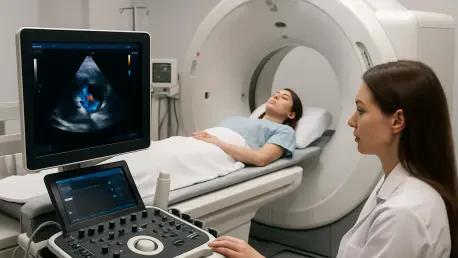The diagnostic imaging market, integral to global healthcare technology, is witnessing remarkable expansion fueled by technological advancements and rising medical demands. Encompassing a variety of imaging modalities—such as X-ray, MRI, CT scans, ultrasound, and nuclear imaging—this sector plays a pivotal role in clinical diagnostics. By providing clear visualizations of internal structures, diagnostic imaging is crucial for accurate diagnoses and effective treatment planning. With the market’s valuation predicted to rise significantly from USD 45.29 billion in 2024 to USD 75.8 billion by 2035, it represents a robust growth trajectory characterized by a compound annual growth rate (CAGR) of 4.80% from 2025 to 2035. This article explores the driving forces behind this growth, industry dynamics, challenges, opportunities, and regional developments impacting the future of the diagnostic imaging market.
Core Drivers of Market Growth
Rising Prevalence of Chronic Diseases
A significant factor propelling the diagnostic imaging market is the increasing incidence of chronic diseases across the globe. Conditions such as cardiovascular diseases, cancer, and neurological disorders require early and precise diagnostic interventions, underscoring the necessity for advanced imaging services. The ongoing demographic shift, marked by an aging global population, is further amplifying market demand. As people age, their susceptibility to chronic illnesses increases, leading to a higher frequency of diagnostic tests. This trend is expected to continue as healthcare systems emphasize the importance of early detection and treatment to enhance patient outcomes.
Advancements in imaging technology are also pivotal in driving market growth. Innovations such as low-radiation CT scanners and portable ultrasound devices have made significant strides in improving patient safety and comfort. These technological developments are complemented by extensive investments in healthcare infrastructure and the adoption of digital health solutions. As emerging markets invest in healthcare modernization, the availability of sophisticated diagnostic imaging systems is expected to expand, thus enhancing the overall market landscape.
Transition to Value-Based Care
Healthcare systems worldwide are shifting from volume-based to value-based care models, with a strong emphasis on diagnostics as a foundation for improving patient outcomes and reducing treatment costs. This shift prioritizes patient-centric care, where diagnostic imaging plays a critical role in formulating effective treatment plans and monitoring therapeutic progress. As this trend gains momentum, the demand for high-resolution diagnostic imaging is expected to rise accordingly.
Moreover, the proliferation of telemedicine and digital health platforms is streamlining diagnostic processes, improving accessibility, and enhancing healthcare delivery in remote regions. The rising adoption of electronic health records (EHRs) and interoperable health systems further underlines the essential role of diagnostic imaging in the contemporary healthcare ecosystem. As healthcare providers integrate advanced imaging with comprehensive data sets, they are better equipped to deliver personalized care, thus driving overall market growth.
Segmentation and Key Players
Product and Application Segmentation
The diagnostic imaging market’s diverse landscape is underscored by its segmentation across various parameters, including product type, application, end-user, and geographic region. Product segmentation spans a wide range of modalities, such as X-ray systems, CT scanners, MRI systems, ultrasound devices, nuclear imaging, SPECT, hybrid PET systems, and mammography systems, each serving distinct diagnostic applications. For instance, MRI is widely used for brain and spinal examinations, while CT scans are favored for detailed bone and joint assessments.
Application segmentation aligns with product utilization, with each modality offering unique insights into different clinical scenarios. Consequently, diagnostic imaging finds extensive application in cardiovascular analysis, neurological investigations, oncological assessments, and musculoskeletal evaluations, significantly influencing clinical decision-making processes. By providing detailed imaging data, these technologies enhance the diagnostic accuracy necessary for developing targeted treatment strategies tailored to individual patient needs.
Leading Industry Stakeholders
Key stakeholders in the diagnostic imaging market include leading companies like GE Healthcare, Siemens Healthineers, Koninklijke Philips N.V., Canon Medical Systems Corporation, FUJIFILM Holdings Corporation, and Hitachi Ltd. These industry giants are instrumental in shaping market dynamics through ongoing innovation, strategic partnerships, and expansive market penetration strategies. By investing in research and development, these companies continue to refine imaging technologies, enhancing image quality, operational efficiency, and diagnostic precision.
Additionally, collaborations between these corporations and healthcare providers facilitate the integration of cutting-edge technologies in clinical practice. By leveraging advancements in artificial intelligence and machine learning, these companies are enhancing image interpretation, optimizing workflow, and providing clinicians with actionable insights. As a result, diagnostic imaging is evolving to offer faster, more accurate diagnostics, supporting improved patient care outcomes worldwide.
Market Dynamics and Trends
Technological Advancements
Technological innovation is at the heart of the diagnostic imaging market’s rapid evolution. One of the most transformative trends is the integration of artificial intelligence (AI) into imaging technologies, revolutionizing radiology workflows. AI-powered systems enhance image analysis, segmentation, and predictive analytics, resulting in improved diagnostic accuracy and decision support. These AI-driven advancements facilitate quicker diagnosis and personalized treatment planning, placing them at the forefront of modern healthcare strategies.
The growing demand for point-of-care imaging solutions also represents a significant trend within the market. Portable and handheld devices, like compact ultrasound machines and mobile X-ray units, are increasingly employed in rural and emergency settings. By facilitating on-site diagnostics, these devices reduce patients’ need for hospital admissions, thus lowering healthcare costs and improving efficiency. Additionally, hybrid imaging systems such as PET/CT and SPECT/CT are gaining traction, especially in oncology and neurology, owing to their ability to provide comprehensive anatomical and functional insights in a single examination.
Cloud and Hybrid Imaging Solutions
Cloud-based imaging solutions are becoming integral to modern healthcare, offering enhanced image sharing, data storage, and accessibility. These systems align with the growing emphasis on electronic health records (EHRs) and interoperable health information exchanges, enabling clinicians to access, analyze, and share imaging data seamlessly. By facilitating secure storage and efficient retrieval, these solutions support collaborative diagnostic efforts and multidisciplinary care.
Advanced visualization techniques, including 4D imaging and contrast-enhanced procedures, further exemplify the market’s dynamic nature. These techniques improve the ability of clinicians to monitor disease progression and therapeutic efficacy, particularly in complex cases. The demand for minimally invasive procedures and precision diagnostics continues to grow, setting new benchmarks for diagnostic imaging capabilities and clinical relevance. As these technologies mature, they promise to transform healthcare delivery, offering unprecedented levels of diagnostic accuracy and efficiency.
Critical Challenges Facing the Market
High Costs and Financial Constraints
Despite the promising growth trajectory, the diagnostic imaging market faces several challenges that could hinder its expansion. One of the primary barriers is the high cost associated with advanced imaging equipment and operational expenses. Modalities such as MRI and PET scanners require substantial upfront investment, ongoing maintenance, and skilled operators, often straining budgets, particularly for smaller healthcare facilities. This financial burden can limit access to state-of-the-art imaging technologies, especially in under-resourced regions.
Concerns about radiation exposure also present challenges for the market. Regulatory bodies have implemented stringent guidelines to minimize patient risk, particularly from frequent CT scans and X-rays. While these measures enhance patient safety, they may also limit the application scope of certain modalities. Additionally, reimbursement complexities and policy variations across different countries affect the accessibility and affordability of advanced imaging procedures, potentially constraining market growth.
Human Resource and Compliance Challenges
The diagnostic imaging market must contend with a shortage of skilled radiologists and technicians, which can delay diagnostic processes and reduce efficiency. This shortage is particularly pronounced in developing regions where training programs and educational resources may be limited. Delays in interpreting and reporting findings impede the timely delivery of patient care, presenting significant challenges to healthcare providers.
Additionally, the sector faces issues related to data management and compliance. The increasing volume of imaging data requires sophisticated IT solutions for effective storage, retrieval, and analysis. Navigating regulatory and compliance requirements, particularly for AI-driven diagnostics, adds another layer of complexity, potentially slowing the adoption of innovative tools. Addressing these challenges is crucial for ensuring the continued advancement of the diagnostic imaging market and its ability to meet the evolving needs of the healthcare industry.
Opportunities for Growth and Innovation
Emerging Market Potential
The diagnostic imaging market presents considerable opportunities for growth and innovation, especially in emerging economies. Countries in Asia-Pacific, Latin America, and Africa represent promising regions for market expansion due to growing healthcare awareness, government support, and investments in healthcare infrastructure. These regions are increasingly prioritizing digital health initiatives and infrastructure development, providing fertile ground for the adoption of advanced imaging systems in hospitals and remote areas.
The proliferation of artificial intelligence and deep learning technologies offers vast potential for developing sophisticated image analysis algorithms that enhance diagnostic accuracy. As healthcare providers increasingly focus on personalized medicine, diagnostic imaging’s role in guiding targeted therapies becomes more pronounced, particularly in areas like oncology and neurology. These technologies empower healthcare providers to deliver personalized care by tailoring treatment strategies to individual patient profiles, potentially improving clinical outcomes and reducing healthcare costs.
Mobile Diagnostics and Strategic Partnerships
Mobile imaging services and home diagnostics represent another avenue for substantial market growth. With the aid of portable devices and cloud-managed data systems, healthcare providers can extend their reach beyond traditional clinical settings, offering diagnostic services in patients’ homes. This flexibility is particularly valuable in geographic regions with limited access to healthcare facilities, improving accessibility and timeliness of care delivery.
Strategic partnerships between public health systems and private diagnostic centers, alongside flexible financing and subscription-based models, further expand market potential. These collaborations enable the pooling of resources, expertise, and technology, facilitating the roll-out of advanced diagnostic solutions. As global healthcare systems prioritize early detection, preventive care, and population health management, the diagnostic imaging market is poised to play a central role in the transformation of healthcare delivery.
Regional Focus: North America’s Market Leadership
Dominant Position in the Market
North America holds a commanding position in the diagnostic imaging market, driven by its advanced healthcare infrastructure, quick technology adoption, and substantial investment in research and development. The United States, in particular, represents a significant portion of this market, benefiting from a high prevalence of diseases and substantial government funding focused on healthcare digitization. These factors, combined with favorable reimbursement policies and investment in cutting-edge technology, have reinforced the region’s leadership in the global diagnostic imaging sector.
The integration of artificial intelligence into medical imaging modalities in North America is enhancing diagnostic accuracy and decision-making speed. By leveraging AI tools for image processing, prediction, and diagnosis, healthcare providers can improve patient outcomes while maintaining cost efficiency. This has positioned North America at the forefront of technological innovation, particularly in deploying advanced solutions that enhance the capabilities of radiology departments across the region.
Innovations in Imaging
One of the key strengths of North America’s diagnostic imaging market lies in its advanced healthcare infrastructure, which has been bolstered by robust research and development investments. These efforts have paved the way for the implementation of cloud-based radiology information systems and picture archiving and communication systems (PACS). These platforms enhance collaboration and data accessibility, supporting healthcare professionals in their diagnostic endeavors and facilitating the transition to electronic health records (EHR).
Moreover, North America is taking the lead in setting global imaging standards through rigorous compliance with safety regulations and continuous innovation. The region remains committed to ensuring the highest standards in imaging safety and quality while embracing new technologies as they emerge. This commitment positions North America at the forefront of global imaging standards, driving further advancements and market expansion.
Navigating the Future
As the diagnostic imaging market advances toward 2035, it plays a pivotal role in shaping the future of healthcare. Driven by technological milestones, evolving healthcare models, and an increasing focus on early diagnosis and prevention, this market offers significant growth potential. Emerging regions provide opportunities for expansion, further fueled by digital health advancements and increased healthcare awareness.
While challenges surrounding cost, regulation, and human resources persist, strategic investments and collaborative partnerships pave the way for innovation and improved access to advanced diagnostic technologies. As stakeholders focus on enhancing precision, interoperability, and affordability, they lay the groundwork for a transformative future. The diagnostic imaging market not only aims to enhance clinical accuracy and efficiency but also strives to redefine its role in delivering patient-centric, value-based care, paving the way for an improved global healthcare landscape by 2035.









